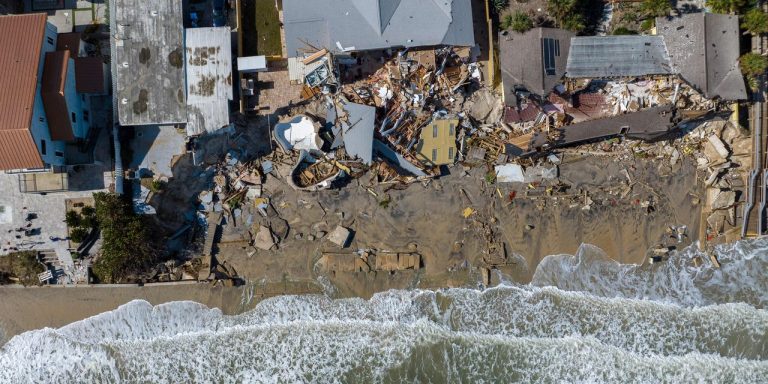The federal government, along with states and municipalities, face the task of preparing for and recovering from the increasingly frequent and severe natural disasters. Companies that help with such efforts could see robust growth along the way.
Lahaina, the historic town on the Hawaiian island of Maui, was reduced to ash last week as wildfires burned through hundreds of acres of land, fueled by an unusually dry summer and strong winds from a passing hurricane.
Natural disasters like this will likely happen more often and incur larger damages in the coming decades, as a warming globe brings unpredictable changes to the climate. As the Atlantic hurricane season is under way, the National Oceanic and Atmospheric Administration recently increased the chance for above-normal storms to 60%, twice as much as its previous forecast in May.
Population growth and rapid urbanization in some of the high-risk areas could make natural disasters particularly damaging. From 2018 to 2022, the U.S. saw an annual average of 18 weather events with over $1 billion losses, well above the average of eight over the past four decades.
The U.S. is expected to spend more on disaster relief efforts, and much of that work would be contracted to the private sector. Meanwhile, businesses and individuals will increasingly seek to protect themselves from the potential climate threat.
“When investors think about climate change, they often end up with companies in renewable energy or those with low carbon footprints,” says Andrew Chanin, CEO of ProcureAM, a exchange-traded fund issuer. “But when hurricanes come or massive drought happens, these aren’t the companies that are getting their hands dirty and rolling up their sleeves to help us to recover.”
His company launched the
Procure Disaster Recovery Strategy
ETF (ticker: FIXT) in 2022, which has a portfolio of 49 companies engaged in natural disaster recovery from different aspects. The fund is up 21% this year. For investors who want to be more selective, here are four stocks to play the theme:
Generac
Power outages tied to severe weather events are becoming more frequent and lasting longer. This has driven up the demand for backup power generators in the past few years.
In 2021, Texas suffered a major power crisis following severe winter storms, while Hurricane Ida left one million Louisiana households in the dark. That year,
Generac Holdings
(GNRC), the largest U.S. manufacturer of backup power generators, saw its sales grow more than 50%, while the stock soared over 125%.
The stock has since fallen back as sales growth softened. So far in 2023, revenue is about 20% down from the same period last year due to weaker consumer demand for home improvement. Management also warned of further weakness in the second half of the year.
The tumbling price has created an opportunity for investors, as long-term demand for backup power will likely continue. Although residential sales came in softer than expected this year, the firm’s continued strength in commercial and industrial segments is underappreciated by the market, according to TD Owen analyst Jefferey Osborne.
“The selloff in shares is exacerbated due to the company’s need to work down its inventory to return to a ‘normalized’ environment,” he wrote in a recent report, noting that power outages in the summer could push the firm back to growth in the fourth quarter.
Generac was a recent Barron’s stock pick in part because the outlook for its residential and commercial businesses is positive.
Wall Street anticipates Generac’s revenue to pick up in 2024, and the stock to rise 31% from its current level, according to analysts polled by FactSet. Shares are now trading at 17 times forward earnings, compared with a five-year average of 22 times.
The stock jumped 4.35% on Monday and is now up 15% year to date. Still, shares are trading 78% below their peak in 2021.
Clean Harbors
Natural catastrophes can leave cities and towns in ruins and professional help is often needed to clean up the debris and respond to any resulting environmental emergencies such as oil spills and hazardous chemicals.
Clean Harbors
(CLH) is a leading provider of such services, working for both companies and governmental agencies. The firm is known for its work in various large-scale incidents, from the 9/11 attack to the
BP
oil spill in the Gulf of Mexico to Hurricane Sandy along the East Coast.
Clean Harbors has expanded quickly in recent years through a series of acquisitions. From 2018 to 2022, revenue increased by 56% while net income expanded more than six times. The stock nearly doubled to reflect the growth. Still, the stock is trading at 23 times forward earnings, well below its five-year average of 31 times, and cheaper than peers like
Waste Management
(WM) and
Republic Services
(RSG), which trade at 25 and 26 times, respectively.
Wall Street analysts expect Clean Harbor to increase revenue by 6% in 2023 and another 5% in 2024 with expanded margins. But if any major disaster hits and the company gets the contract to handle the mess, the gains would be much more than that. After Hurricane Sandy devastated much of the northeastern coastline, including New York City, in October 2012, Clean Harbors’ revenue jumped 60% the following year.
Skyline Champion
When homes get destroyed, people need a place to live until they can return. Enter
Skyline Champion
(SKY), a leading producer of manufactured and modular homes including temporary housing units for disaster relief.
Sales soared in 2022 as the firm delivered a large order for temporary housing from the Federal Emergency Management Agency, one of its major government clients. There is no active order now, but that could certainly change if there is a pickup in natural disasters in the coming years.
“Going all the way back to Hurricane Katrina in 2005, the manufactured housing industry has been partnering with FEMA to produce temporary housing for people in need,” says Wedbush analyst Jay McCanless, “If we see another Katrina level disaster, it wouldn’t surprise me if FEMA spread out [their orders].”
Skyline is seeing decline in revenue and production this year as manufactured home communities paused orders to keep a lean inventory amid higher carrying cost, management said in a recent earnings call. Average selling price also decreased as consumers shifted to cheaper models amid high interest rates.
Still, consumer demand for affordable housing remains strong in the inflationary environment. After Hurricane Ian wiped out many mobile home parks in Florida last year, Skyline said it’s ramping up production to meet the anticipated demand. Analysts polled by FactSet expect sales to grow 10% in fiscal year 2025, which spans from March 2024 to March 2025, from the earlier one-year period. The stock now trades at 18 times forward earnings, below its five-year average of 21 times.
Oshkosh
Wildfires have become more frequent and destructive as summers get hotter and dryer.
Oshkosh
(OSK), a company that designs and builds specialty vehicles, recently said that demand for its firetrucks has been outpacing supply as cities around the country upgrade their firefighting fleet. This has led to some backlog orders, but the firm is working hard to increase production capacity over the next year.
Oshkosh’s revenue tanked during the pandemic, but has been recovering ever since. “Municipal budgets are healthy and they’re prioritizing things like critical firetrucks in their fleets,” said CEO John Pfeifer in the latest earnings call. There is a significantly aged fleet of firetrucks across the country, he told analysts, and the firm expects demand to be strong for the foreseeable future.
Interest is particularly strong for the electric models. “It’s kind of hard to predict just how fast fleets will electrify, but I will tell you that every time we put an electric unit into the market, it’s a higher price point,” said Pfeifer, “There’s no reason why our products don’t get back to prepandemic levels with the pricing we have.”
Oshkosh’s other business segments have delivered solid performances as well. Analysts expect sales to grow 15% in 2023 and earnings to more than double from last year, according to FactSet. The stock has gained 38% in the past three months but trades at just 12 times forward earnings, below its five-year average of 13 times.
Write to Evie Liu at [email protected]
Read the full article here









